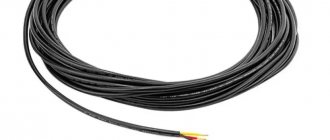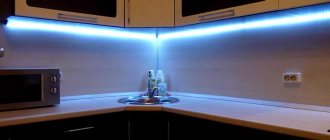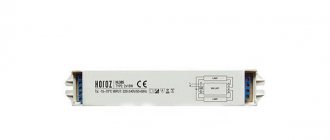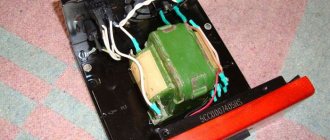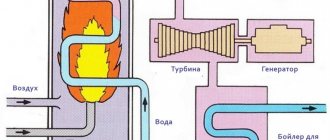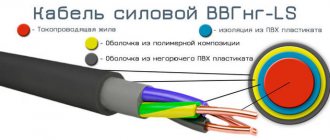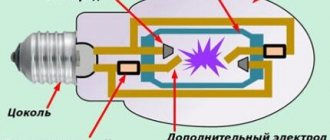Hello. The topic of today's article is “ Cable cross-section by power ”. This information will be useful both at home and at work. We will talk about how to calculate the cable cross-section by power and make a choice using a convenient table.
Why do you need to choose the right cable cross-section?
In simple terms, this is necessary for the normal operation of everything related to electric current. Be it a hair dryer, washing machine, motor or transformer. Today, innovations have not yet reached the wireless transmission of electricity (I think they will not reach it soon); therefore, the main means for transmitting and distributing electric current are cables and wires.
With a small cable cross-section and high power equipment, the cable can heat up, which leads to loss of its properties and destruction of the insulation. This is not good, so correct calculation is necessary.
So, the choice of cable cross-section according to power . For selection we will use a convenient table:
The table is simple, I don’t think it’s worth describing it.
Now we need to calculate the total power consumption of equipment and devices used in an apartment, house, workshop or any other place where we run the cable. Let's calculate the power.
Let's say we have a house, we are installing closed electrical wiring using a VVG cable. Take a sheet of paper and copy down the list of equipment used. Done? Fine.
How to find out the power? You can find the power on the equipment itself; there is usually a tag where the main characteristics are written down:
Power is measured in Watts (W, W), or Kilowatts (kW, KW). Found it? We record the data, then add it up.
Let's say you get 20,000 W, that's 20 kW. The figure tells us how much energy all electrical receivers consume together. Now you need to think about how many devices you will use simultaneously over a long period of time? Let's say 80%. The simultaneity coefficient in this case is 0.8. We calculate the cable cross-section by power :
We count: 20 x 0.8 = 16 (kW)
To make a choice of cable cross-section based on power, look at our tables:
For a three-phase 380 Volt circuit it will look like this:
As you can see, it's not difficult. I would also like to add that I advise you to choose a cable or wire with the largest cross-section of cores, in case you want to connect something else .
Related posts:
- When Power Engineer's Day in Russia in 2012 was special.
- If you are planning to study to become an electrician, I recommend reading where to study and how to get an electrician diploma
- Electrical personnel, groups
- Electrician profession, prospects
Useful advice: if you suddenly find yourself in an unfamiliar area at night. Don't use your cell phone to light your way
That's all for me, now you know how to select the cable cross-section according to power. Feel free to share with your friends on social networks.
When repairing and designing electrical equipment, it becomes necessary to choose the right wires. You can use a special calculator or reference book. But for this you need to know the load parameters and cable laying features.
Why do you need to calculate the cable cross-section?
The following requirements apply to electrical networks:
If the selected cross-sectional area of the wire is small, then the current loads on the cables and wires will be large, which will lead to overheating. As a result, an emergency may occur that will damage all electrical equipment and become dangerous to the life and health of people.
If you install wires with a large cross-sectional area, then safe use is ensured. But from a financial point of view there will be cost overruns. The correct choice of wire cross-section is the key to long-term safe operation and rational use of financial resources.
The cable cross-section is calculated based on power and current. Let's look at examples. To determine what wire cross-section is needed for 5 kW , you will need to use the PUE tables (“Electrical Installation Rules”). This directory is a regulatory document. It states that the choice of cable cross-section is made according to 4 criteria:
- Supply voltage (single-phase or three-phase).
- Conductor material.
- Load current, measured in amperes (A), or power - in kilowatts (kW).
- Cable location.
There is no value in the PUE for 5 kW , so you will have to choose the next larger value - 5.5 kW . For installation in an apartment today it is necessary to use copper wire. In most cases, installation is by air, so a cross-section of 2.5 mm² is suitable from the reference tables. In this case, the maximum permissible current load will be 25 A.
The above reference book also regulates the current for which the input circuit breaker is designed ( VA ). According to the “ Electrical Installation Rules ”, with a load of 5.5 kW, the VA current should be 25 A. The document states that the rated current of the wire that is suitable for a house or apartment should be an order of magnitude greater than that of the VA. In this case, after 25 A there is 35 A. The last value must be taken as the calculated one. A current of 35 A corresponds to a cross section of 4 mm² and a power of 7.7 kW. So, the choice of the cross-section of the copper wire according to power is completed: 4 mm².
To find out what wire cross-section is needed for 10 kW , we will again use the reference book. If we consider the case for open wiring, then we need to decide on the cable material and the supply voltage.
For example , for an aluminum wire and a voltage of 220 V, the next highest power will be 13 kW, the corresponding cross-section is 10 mm²; for 380 V the power will be 12 kW and the cross-section will be 4 mm².
What cable is needed to connect a house to a 15 kW electrical network?
When building his own home, every owner must take care of its arrangement and comfort. The first step is to connect it to the power supply. The legislation allows the consumption of electricity of different power depending on the energy consumed. Therefore, you must first determine the resource consumption, and then determine what cross-section of the central cable will be required to install the outlet to your home.
Today, people use many electrical appliances that they need for a comfortable life and convenience. They consume a lot of electrical resources. A private house is usually allocated a power of 15 kW, which is enough to fully use electricity without overloading the power grid.
How to calculate by current
The amount of current passing through a conductor depends on the length, width, resistivity of the latter and on temperature. When heated, the electric current decreases. Reference information is given for room temperature (18°C). To select the cable cross-section for current, use the PUE tables.
Table 3. Electric current for copper wires and cords with rubber and PVC insulation
| Conductor cross-sectional area, mm² | Current, A, for wires laid | |||||
| open | in one pipe | |||||
| two single-core | three single-core | four single-core | one two-wire | one three-wire | ||
| 0,5 | 11 | — | — | — | — | — |
| 0,75 | 15 | — | — | — | — | — |
| 1 | 17 | 16 | 15 | 14 | 15 | 14 |
| 1,2 | 20 | 18 | 16 | 15 | 16 | 14,5 |
| 1,5 | 23 | 19 | 17 | 16 | 18 | 15 |
| 2 | 26 | 24 | 22 | 20 | 23 | 19 |
| 2,5 | 30 | 27 | 25 | 25 | 25 | 21 |
| 3 | 34 | 32 | 28 | 26 | 28 | 24 |
| 4 | 41 | 38 | 35 | 30 | 32 | 27 |
| 5 | 46 | 42 | 39 | 34 | 37 | 31 |
| 6 | 50 | 46 | 42 | 40 | 40 | 34 |
| 8 | 62 | 54 | 51 | 46 | 48 | 43 |
| 10 | 80 | 70 | 60 | 50 | 55 | 50 |
| 16 | 100 | 85 | 80 | 75 | 80 | 70 |
| 25 | 140 | 115 | 100 | 90 | 100 | 85 |
| 35 | 170 | 135 | 125 | 115 | 125 | 100 |
| 50 | 215 | 185 | 170 | 150 | 160 | 135 |
| 70 | 270 | 225 | 210 | 185 | 195 | 175 |
| 95 | 330 | 275 | 255 | 225 | 245 | 215 |
| 120 | 385 | 315 | 290 | 260 | 295 | 250 |
| 150 | 440 | 360 | 330 | — | — | — |
| 185 | 510 | — | — | — | — | — |
| 240 | 605 | — | — | — | — | — |
| 300 | 695 | — | — | — | — | — |
| 400 | 830 | — | — | — | — | — |
A table is used to calculate aluminum wires.
Table 4. Electric current for aluminum wires and cords with rubber and PVC insulation
| Conductor cross-sectional area, mm² | Current, A, for wires laid | |||||
| open | in one pipe | |||||
| two single-core | three single-core | four single-core | one two-wire | one three-wire | ||
| 2 | 21 | 19 | 18 | 15 | 17 | 14 |
| 2,5 | 24 | 20 | 19 | 19 | 19 | 16 |
| 3 | 27 | 24 | 22 | 21 | 22 | 18 |
| 4 | 32 | 28 | 28 | 23 | 25 | 21 |
| 5 | 36 | 32 | 30 | 27 | 28 | 24 |
| 6 | 39 | 36 | 32 | 30 | 31 | 26 |
| 8 | 46 | 43 | 40 | 37 | 38 | 32 |
| 10 | 60 | 50 | 47 | 39 | 42 | 38 |
| 16 | 75 | 60 | 60 | 55 | 60 | 55 |
| 25 | 105 | 85 | 80 | 70 | 75 | 65 |
| 35 | 130 | 100 | 95 | 85 | 95 | 75 |
| 50 | 165 | 140 | 130 | 120 | 125 | 105 |
| 70 | 210 | 175 | 165 | 140 | 150 | 135 |
| 95 | 255 | 215 | 200 | 175 | 190 | 165 |
| 120 | 295 | 245 | 220 | 200 | 230 | 190 |
| 150 | 340 | 275 | 255 | — | — | — |
| 185 | 390 | — | — | — | — | — |
| 240 | 465 | — | — | — | — | — |
| 300 | 535 | — | — | — | — | — |
| 400 | 645 | — | — | — | — | — |
Calculation of cable cross-section by power and length
The cable length affects the voltage loss. Thus, the voltage at the end of the conductor may decrease and be insufficient to operate the electrical appliance. For household electrical networks, these losses can be neglected. It will be enough to take a cable 10-15 cm longer. This reserve will be used for switching and connection. If the ends of the wire are connected to the shield, then the spare length should be even greater, since circuit breakers will be connected.
When laying cables over long distances, voltage drop must be taken into account. Each conductor is characterized by electrical resistance. This parameter is affected by:
- Wire length, unit of measurement – m. As it increases, losses increase.
- Cross-sectional area, measured in mm². As it increases, the voltage drop decreases.
- Material resistivity (reference value). Shows the resistance of a wire measuring 1 square millimeter per 1 meter.
The voltage drop is numerically equal to the product of resistance and current. It is acceptable that the specified value does not exceed 5%. Otherwise, you need to take a cable with a larger cross-section. Algorithm for calculating wire cross-section based on maximum power and length:
- Depending on the power P, voltage U and cosph , we find the current using the formula: I=P/(U*cosph) . For electrical networks used in everyday life, cosф = 1 . In industry, cosph is calculated as the ratio of active power to total power. The latter consists of active and reactive powers.
- Using PUE tables, the current cross-section of the wire is determined.
- We calculate the resistance of the conductor using the formula: Ro=ρ*l/S , where ρ is the resistivity of the material, l is the length of the conductor, S is the cross-sectional area. It is necessary to take into account the fact that current flows through the cable not only in one direction, but also back. Therefore, the total resistance: R = Ro*2 .
- We find the voltage drop from the relationship: ΔU=I*R .
- We determine the voltage drop as a percentage: ΔU/U . If the obtained value exceeds 5%, then select the nearest larger cross-section of the conductor from the reference book.
Which input is better to choose: single-phase or three-phase?
When installing electricity into a new home, it is necessary to use materials that guarantee safety. This applies to both external and internal electrical work, which must be carried out by qualified specialists.
There are two types of connection to the electrical network - single-phase and three-phase. In both cases, the documentation issued by the energy supply organization must contain all the data described in the technical specifications. The use of one or the other method is determined by the possibility of installing wiring of a smaller diameter, which allows the load to be evenly distributed across three phases.
However, for a three-phase network, a larger distribution panel will be required so that several modules can be connected. This also applies to the RCD protective system. But this drawback is insignificant, since its main advantage is that it allows you to connect asynchronous electrical units, such as boilers, electric boilers, furnaces and heaters.
As a rule, a three-phase network operates at a voltage of 380 V, so electricians install special distributors that allow them to evenly distribute the load, as well as additional three-phase circuit breakers. This ensures the safe use of powerful electrical appliances, and also eliminates the possibility of a short circuit or fire.
Open and closed wiring
Depending on the placement, wiring is divided into 2 types:
Today, hidden wiring is installed in apartments. Special recesses are created in the walls and ceilings to accommodate cables. After installing the conductors, the recesses are plastered. Copper wires are used. Everything is planned in advance, because over time, to build up electrical wiring or replace elements, you will have to dismantle the finishing. For hidden finishing, wires and cables that have a flat shape are often used.
When laid open, the wires are installed along the surface of the room. Advantages are given to flexible conductors that have a round shape. They are easy to install in cable channels and pass through the corrugation. When calculating the load on the cable, the method of laying the wiring is taken into account.
If you are the owner of a dacha or a country house (or perhaps you are going to join the audience of developers), and your site is located in a settlement where the use of land for individual housing construction (individual housing construction) is permitted, then by law you are entitled to a connection to networks with full power 15 kW. Whereas in dacha cooperatives and gardening partnerships they use a power of 4 or 6 kW.
A power of 15 kW will allow you to organize a cozy home life, where household electrical appliances, their quantity and operational capabilities are of great importance.
Electrical installation work is carried out according to a project created on the basis of technical specifications (TU). And this document is developed individually for each farm. To do this, you must submit an application to the energy supply organization, where you indicate the desired connection power (15 kW) and voltage (230/400V). You will receive these values by first calculating the total power consumption of your electrical appliances.
Taking into account the data of your application and the capabilities of the power line, local electrical networks or the organization to which they belong will issue you a technical specification, which will indicate the figures of the permitted power, as well as the cross-section of the line cables, their brand and type. As well as requirements for grounding, lightning protection, switching and protective equipment, meters, automatic devices, RCDs.
In the creation of a project that is carried out by specialized and licensed organizations on the basis of this specification, PUE and SNiP, you must take an active part in order to be aware of all the nuances.
Installation of external electrical wiring
Any technical work related to construction is carried out in accordance with the developed project, which is carried out by specialists. To connect to the power grid, you must submit an application to the energy supply service that serves the building area. The document must indicate the optimal power and voltage required by the user.
The numbers can be calculated based on the total power of the estimated energy consumption of all electrical appliances. Based on this data, the relevant authorities issue a permit in accordance with the technical data, which describes the permissible power, voltage, wire cross-section, grounding rules, as well as protective and fixing equipment.
To connect a house to a 15 kW power grid, a voltage of 230-400 V is required, and the meter must have the appropriate machines.
Electric installation work
We will not dwell in more detail on the preparation of documentation for connecting the power supply; this is a separate topic. Our task is to determine the materials and devices for external installation work, which, although they are an intermediate stage in the connection, are the most important, since they are related to human safety.
Single-phase or three-phase input?
For both three-phase and single-phase networks, the permitted power is indicated in the technical specifications. This can be 15 kW for both options, that is, the benefit of a three-phase network is not in power, but in the possibility of using an input cable of a smaller cross-section and reducing the load, since the current is distributed over 3 phases. Therefore, in a three-phase network, the rating of the input circuit breaker will be lower.
But the input distribution board will be increased in size, since the meter itself is larger than a single-phase one, and the circuit breakers occupy 3-4 modules. Three-phase RCDs also have larger dimensions. This is a disadvantage of three-phase input into the house, but it is not very significant compared to such advantages as the ability to connect asynchronous electric drives, electric boilers, heaters, and electric stoves in the house.
What is the difficulty in choosing what cross-section is needed for 15 kW?
The main problem in choosing what cross section is needed for 15 kW is that different information resources provide different information. At the same time, in such articles you can read both excerpts from textbooks and many incomprehensible formulas compiled directly by electricians and for electricians. All this, seasoned with advice from “experienced” people, only complicates the process of choosing what cross-section is needed for 15 kW.
Why is this happening? A huge amount of information, assumptions, nuances - there is no general answer to this question. What cross-section is needed for 15 kW depends, among other things, on your situation and connection method. The method of laying the cable (underground or overhead), the total number of power-receiving devices and the simultaneous load on the network, as well as many additional parameters are taken into account.
We told you what cross-section is needed for 15 kW in most standard cases: 4 sq. mm (square millimeters), however, in case of heavy load on the network, this value can be increased.
